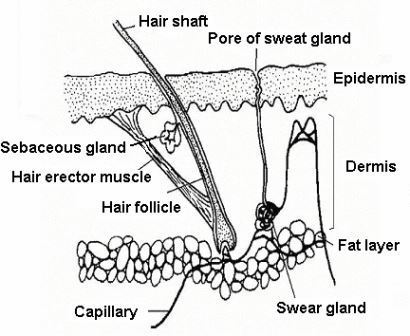a) Skin
The skin covers the body and prevents dust and germs to enter the body. When the skin is broken by cut, scratch or bite, germs can enter. Skin also protects the body from drying up. The skin is made up of two layers namely: Epidermis (top layer) and Dermis (underneath layer).
Epidermis: This is the upper layer of the skin. It is made up of the dead cells on the top and below is living cells. The living cells contain pigment (colouring) which is different in different areas. This colour of the pigment determines the colour of our skin. The cells die to replace the worn out cells.
Dermis:
This is the lower part of the skin which contains many things

Parts of Skin and Their Functions
Tinny blood vessels:
For the supply of food and oxygen to the living parts of the skin.
Nerves:
There are a number of nerves: e.g. for feeling cold, pain, touch, and pressure.
Oil glands:
These make oil to oil the hair and keep the skin soft.
Glands:
These are responsible for secreting sweat as a waste product.
General Functions of Skin:
Excretion:
Waste products from the blood are excreted from the capillaries surrounding the gland in form of sweat via pores.
Feelings:
There are millions of nerve ends in the skin. There are different nerve ends for feeling e.g. touch, cold, pain and pleasure.
Maintaining Constant body temperature:
The body vessels expand when the body is hot. This allows more heat to escape by radiation. Sweat glands produce sweat and when this sweat evaporates, cooling is produced. The blood vessels contract when the body is cold and glands secret less sweat. This way, the skin looses less heat.
Mutiso answered the question on
October 7, 2018 at 11:55